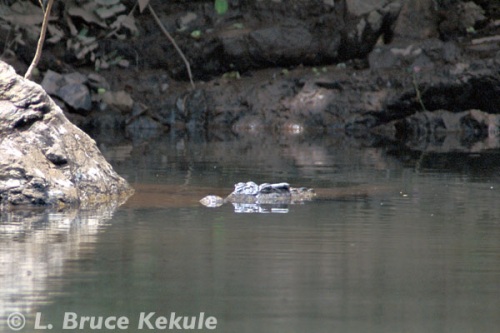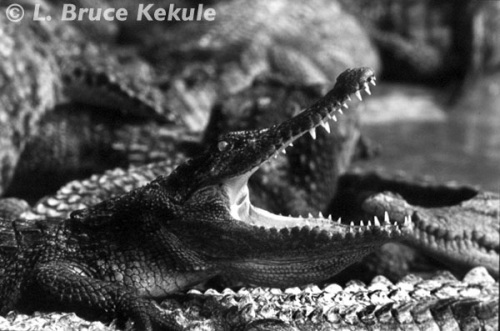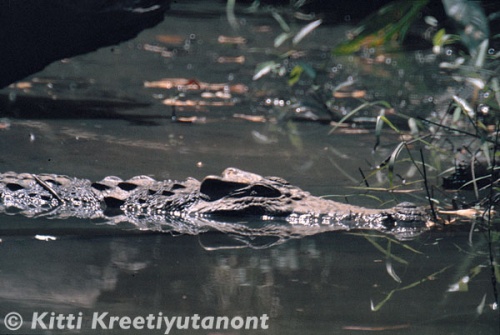Posts Tagged ‘Southeast Asia’
The Siamese Crocodile – Update 2011
Critically endangered crocodilian species
Thailand’s last few remaining wild crocodiles
Two hundred and thirty million years ago, the first crocodilians evolved from archosaurs or ‘ruling reptiles’ during the mid-Triassic period of the Mesozoic era when primitive dinosaurs also roamed the planet. Crocodiles have changed little in body structure since then. Apart from birds, these reptiles are the only living archosaurs.
My first Siamese crocodile in Khao Ang Rue Nai Wildlife Sanctuary
“Note forest fly on the eye node; these insects take saline from the croc’s eyes”
In 1909, J.B. Hatcher discovered a few fossilized bits and pieces of a giant alligator in Montana from the late Cretaceous period 80 million years ago. Deinosuchus was also found in Texas by Barnum Brown of the American Museum of Natural History in New York in the 1940s. The skull of this huge crocodilian is two meters long and body length estimated at about 12 meters with a weight of 8.5 tons.
Sarcosuchus was another crocodile some 12 meters long and weighing up to 10 tons. Fossils were first found in Central Africa from the early Cretaceous 112 million years ago by French paleontologist Albert-Felix de Lapparent in 1964, and then by France de Broin and Phillip Taquet in 1966. Later in 1997, Paul Sereno discovered more fossils in the sub-Sahara desert and then tagged the beast as ‘Super-Croc’.
This huge crocodilian was also unearthed in Brazil by a British geologist, and described by Eric Buffetaut and P. Taquet in 1977 as the same species found in Africa. These ‘super-crocs’ pulled dinosaurs and other large animals into the water and devoured them.
The same crocodile camera trapped in Khao Ang Rue Nai
In 1979, Nares Sattayarak, a geologist for the Department of Mineral Resources working in the northeast province of Nong Bua Lamphu discovered the lower jaw of a huge crocodile in a road-cut excavated from the Phu Kradung Formation of the late Jurrasic 150 million years ago. Named Sunosuchus thailandicus, it was described as a new species by Eric Buffetaut and Rucha Ingavat. Estimated to have been at least eight meters in length with a lower jaw over a meter long, it was Thailand’s ‘super-croc’.
Then in 2005 a fossil several million years old of a ‘gavial’, a large fish-eating crocodilian was unearthed by Dr Yaowalak Chaimanee and her team from the Department of Mineral Resources. This discovery was made on the Khorat Plateau at Ban Khok Sung in Nakhon Ratchasima province. The species still exists in Burma and India.
Sometime in 2006, Komsorn Lauprasert, a scientist at Mahasarakham University discovered another species of crocodilian 100 million years old that had longer legs than modern-day crocodiles and probably fed on fish, based on the characteristics of its teeth.
My second Siamese crocodile in Kaeng Krachan National park
According to Komsorn, “They were living on land and could run very fast”. The 15cm. long fossil-skull was originally retrieved from an excavation site in Nakhon Rathchasima province and then found in a museum. The species has been named Khoratosuchus jintasakuli after the province and the last name of the director of the Northeastern Research Institute of Petrified Wood and Mineral Resources, Pratueng Jintasakul.
Some 50 years ago, Thailand had three species of wild crocodiles found in a host of environments: the sea, estuaries, rivers and marshes. The most common species was the Siamese crocodile (Crocodylus siamensis) and was considered a pest by village folk who lived near waterways that had the reptiles.
Another thin-snouted freshwater crocodile was (Tomistoma schlegelii), also known as the ‘false gharial’ found only in rivers of the southern peninsula.
Crocodile river in Khao Ang Rue Nai
The estuarine ‘saltwater’ crocodile (Crocodylus porosus) today is the largest in the world also known as the ‘Indo-Pacific’ crocodile. The species was very common in river estuaries and islands in the Andaman Sea and the Gulf of Thailand. Huge saltwater crocs have been sighted swimming in open-ocean.
Unfortunately, both the saltwater and false gharial has disappeared from the wild of Thailand, and the Siamese is technically extinct with only two individuals left; one in the East and one in the West of the Kingdom. This is truly a sad state of affairs concerning the crocodile after having outlived the dinosaurs for more than 65 million years.
The Siamese crocodile was once very common in Southeast Asia including Thailand, Vietnam, Cambodia, Indonesia, Malaysia, Laos and possibly Burma. Populations throughout the region have seriously declined and exact numbers of wild crocs are not known in any of the range countries.
Wild Siamese crocodile in southern Cambodia
There is a small population still thriving in Cambodia. However, their habitats are under serious threat from hydroelectric dam construction and could be wiped out very soon.
Conservationists from ‘Flora and Fauna International’ and ‘Wildlife Alliance’ are capturing wild Siamese crocodiles and plan to use these to launch a conservation breeding-program in partnership with the Cambodian Forestry Administration. My close friend and English wildlife photographer Allan Michaud has photographed a Siamese crocodile in southern Cambodia.
Crocodilians for most of their 230-million-year history have been large, long-bodied, aquatic carnivores. Armor plating (in the form of bony scutes set in their hides), extended tails, short strong limbs, and powerful sharp-toothed jaws make them formidable predators.
Crocodile tracks by the Phetchaburi River
Crocodiles come onto land to defecate and, being cold-blooded, to bask in the sun to regulate their body temperature. Female crocs come ashore to lay 20 to 40 eggs in mound nests on land near the water’s edge. These streamlined submarine predators glide through water with ease, surfacing and submerging at will.
Siamese crocs grow broad and heavy, and mature individuals have distinct bony ridges behind the eye socket. Historical records report specimens of up to four meters in length but three meters is the average for a mature adult. They feed primarily on fish but also take frogs, small mammals and birds. Undulating their powerful tails while tucking in their legs, crocs can glide through water without making a ripple.
Stealthily stalking prey along the water’s edge, they can snatch in an instant with powerful jaws pulling it below to drown their victim. Some crocs lay in wait on the bottom of a river or pond in order to grab fish and can stay underwater for an extended period of time.
Crocodile pond in the Phetchaburi River
If the carcass is too large to swallow whole, they stash it under water until ripe and then tear it apart. Adults can survive for many months without a meal and thus are one of nature’s most efficient predators in terms of consumption proportionate to body size.
Man is the crocodile’s only enemy, and the wild Siamese crocodile is probably the most endangered crocodilian species in the world wiped out by man’s greed.
At the end of World War II, crocodile farming came into vogue in the Kingdom, and wild crocs were captured for breeding stock. Thousands upon thousands were caught in the booming trade. Habitat loss and crocodile farming started the countdown to extinction for these ancient creatures. With no laws to protect them, crocs were eradicated from every river and swamp in the country.
River carp at the crocodile pond in the Phetcahburi River
Farming crocodiles is big money business in Thailand. The false gharial and saltwater crocs are farmed along with the Siamese. A quick growing crocodile has been produced by crossbreeding the Siamese with the ‘saltwater’ species producing a ‘hybrid’ found in most of the farms throughout the country. This human ‘quick-growing’ creation is farmed for its meat and hide, and continues to be a brisk business.
The recent floods in the Central Plains have allowed hundreds of legally and illegally farmed crocodiles to escape into the environment. Many have been shot, some captured and some are still on the loose. The danger to humans is probably nil. However, farmed crocs are much more aggressive than wild ones and if one is sighted, the authorities should be notified immediately.
During my career as a wildlife photographer, I have had the great fortune to photograph two crocodiles in the wild: the first one in 2001 at Khao Ang Rue Nai Wildlife Sanctuary in the East, and in 2003, the second one in the Phetchaburi River in Kaeng Krachan National Park in the Southwest. I also camera trapped the first one in 2002 shown in the lead photograph.
Siamese crocodile in the Samut Prakan Crocodile Farm
One thing has been determined about these two creatures: The old croc in Khao Ang Rue Nai is probably a male (no egg nests have ever been found here), while the mature individual in Kaeng Krachan is more likely a female as many nests have been found up-and-down the river over the years but the eggs are never fertile. Female crocs lay eggs regardless of fertilization by a male or not. The possibility of bringing the two together to mate is absolutely zero.
Some old reports suggest that Siamese crocodiles could still exist in the northeast in several other protected areas: Pang Sida National Park (Sa Kaeo province), Phu Khieo Wildlife Sanctuary (Chaiyaphum province) and Yot Dom Wildlife Sanctuary (Ubon Ratchathani province) but with no actual records, it is doubtful if they still survive in these locations.
My good friend Kitti Kreetiyutanont of the National Parks, Wildlife and Plant Conservation Department (DNP) wrote a paper on Siamese croc sightings in 1993 and, indeed, photographed one at Khao Ang Rue Nai. It is thought to be the same animal I photographed. In 2003, poachers in Yot Dom near the border with Cambodia killed a female crocodile with eggs, and its skull and skin are on display at the park.
Siamese crocodile photographed in Khao Ang Rue Nai
The DNP and other organizations should support surveys to see if any other wild crocodiles still exist in Thailand. Restocking a few carefully selected sites with yearling purebred Siamese crocodiles seems to be the only solution.
But that raises questions about the suitability of the farmed crocs available for release. Have captive animals been excessively inbred? Even more critical, have they been crossbred with other species? Only good genetic DNA analysis can unravel this intricate problem of the species’ integrity in the farms.
In 2004, the DNP in conjunction with a local crocodile farm started a pilot project to reintroduce Siamese crocodiles at Pang Sida National Park. Seven juveniles were being kept in a holding pen for future release close to Pang Sida waterfall. However, it is reported that a few escaped and the farm abandoned the project.
Over the last few years, newspaper reports of crocodiles seen in Khao Yai and Thung Salang Luang national parks were probably released without the DNP’s knowledge, and more likely to create media frenzy by someone.
The croc in Khao Yai is aggressive as several tourists found out one day standing by the banks of the river where the croc is living. The reptile rushed up to the people probably looking for food. The chief then roped off the area by the waterway. Siamese crocodiles are very secretive and avoid people period, and are difficult to see in the wild. The department should capture this croc and remove it being alien to this place above Haew Suwat waterfall.
Serious efforts are required to save Thailand’s remaining wild crocodiles. No matter how many crocodiles are kept in farms, only an intact natural population can truly save these ancient creatures from total extinction.
Thailand should serve as a role model for wildlife conservation in Southeast Asia, and the Thai people and the government should join hands to save and protect the Siamese crocodile for present and future generations. Action needs to be undertaken now to ensure that a creature of 230-million year evolution continues to survive.
Goral in Mae Lao-Mae Sae Wildlife Sanctaury – Northern Thailand
From June to August 2011, I set a Bushnell Trophy Cam on video mode at the top of ‘Mon Liem’ mountain in the sanctuary. After collecting the camera, many clips of goral were taken, both during the day and at night. This is just a few of those clips.
Asian tuskless bull elephant in Huai Kha Khaeng
A huge tuskless bull elephant at a mineral lick in Huai Kha Khaeng Wildlife Sanctuary
This bull has been involved in a few close encounters with rangers, and actually killed one man while he was riding his motorcycle along the road in the sanctuary. These old elephants are to be avoided at all cost. I certainly stay out of their way when I’m working in this World Heritage Site which means slow and deliberate movement is essential and ears and eyes on high alert when walking through this forest.
Poacher camera trapped in Mae Lao-Mae Sae Wildlife Sanctuary
Silent video is not noticed by a low-land village man scouting for game or forest products
This hunter/gatherer was caught by a very sensitive Bushnell Trophy Cam set on video mode during May-June 2011 up the mountain in this protected area. He was probably Hmong or Karen hill-tribe but had no gun. But this does not mean he did not have rope or wire sling, and poison in his backpack, or had already set some snares near wildlife concentrations like mineral licks. These are the main tools for poachers now-days. More camera trapping of this sanctuary is needed to get face recognition of people who illegally entering this place. Look for future posts of this nature.
Pig-tailed Macaque in Mae Lao-Mae Sae Wildlife Sanctuary
A mature pig-tailed macaque up on a ridge-line in the sanctuary
This monkey showed-up in front of a Bushnell Trophy Cam set to video, and then made an amazing leap to a tree overlooking the lower valley. As a loner or solitary primate, he must have been pushed out of the group by a larger male. But the big question: What was he doing all the way at the top of this mountain?
Asian Wild Dogs in Mae Lao-Mae Sae Wildlife Sanctuary: Part Two & Three
Wild dogs pass a Bushnell Trophy Cam a few days later:
These videos once again demonstrate Thailand’s beautiful and amazing natural heritage, and the fact these carnivores are still thriving in the North formally thought to be extinct.











